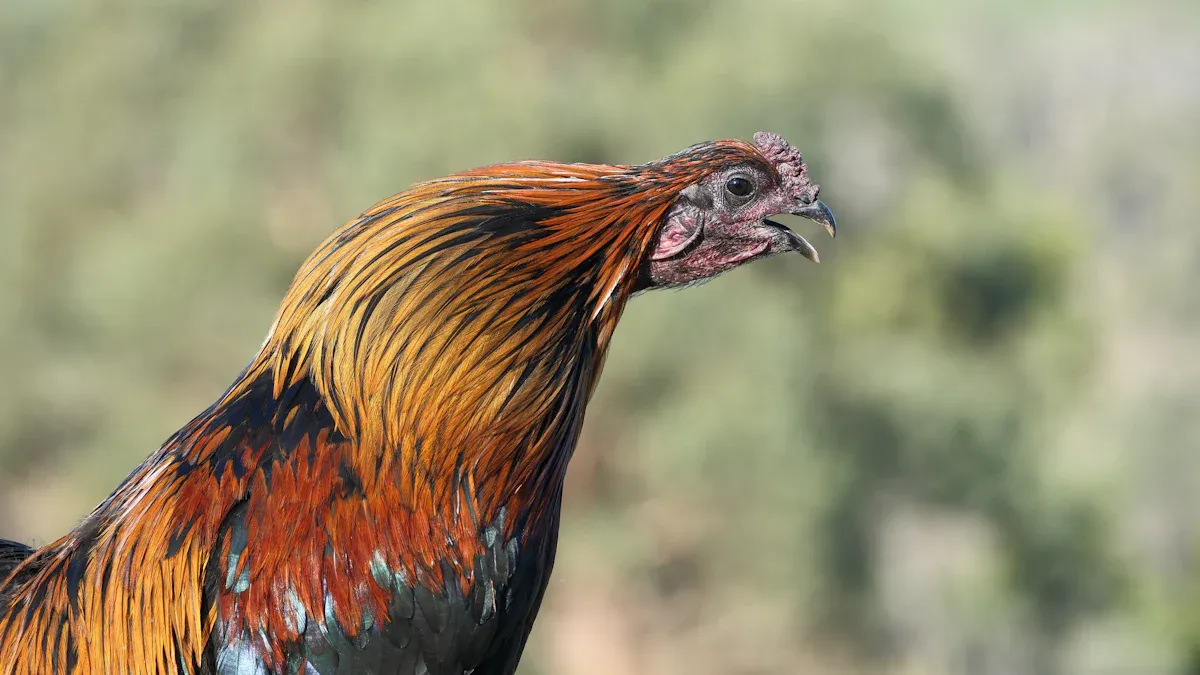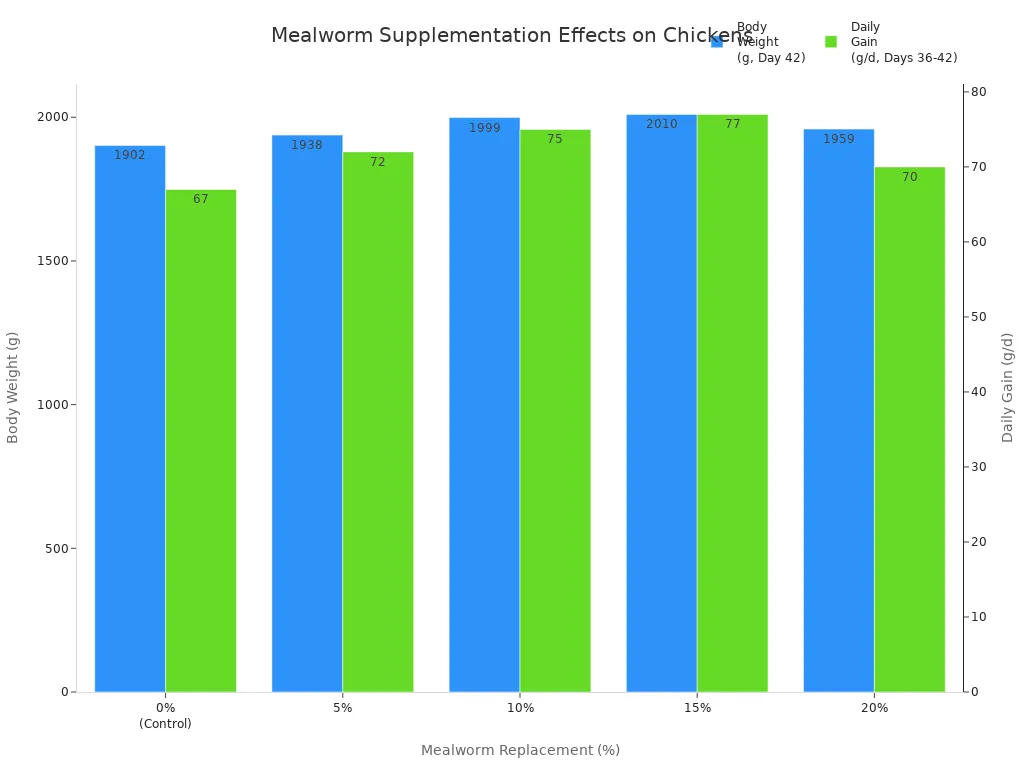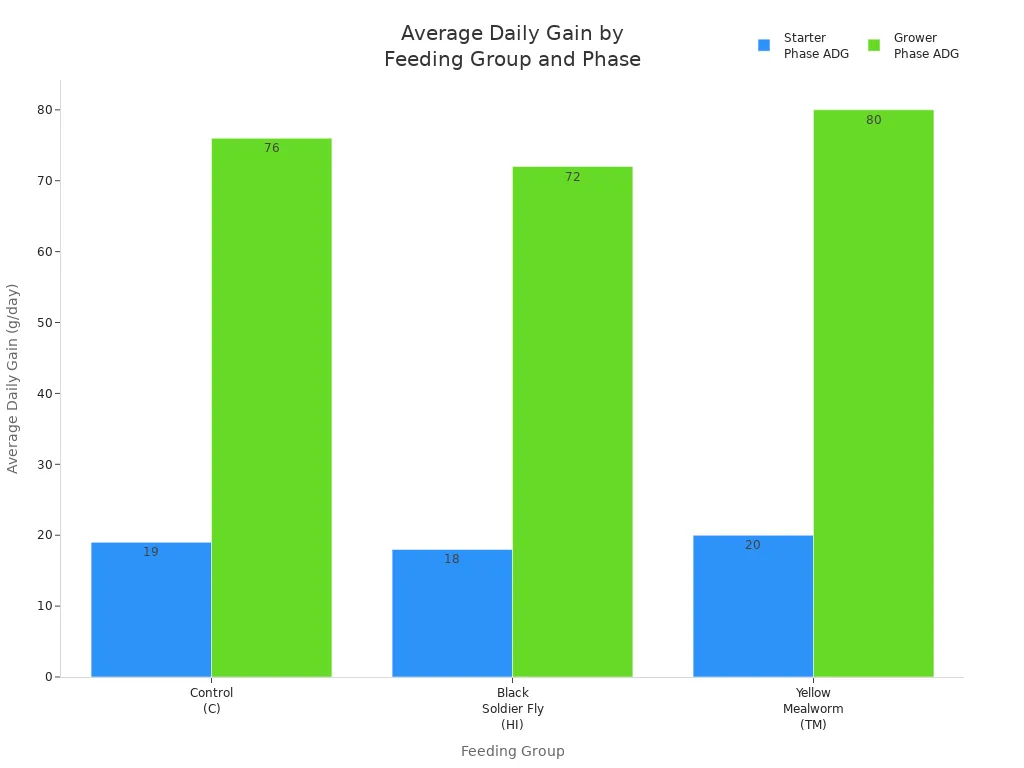
Chickens love a tasty snack, and mealworms for chickens bulk deliver more than just flavor. Studies show chickens munching on these treats grow faster, gain more weight, and lay eggs with richer yolks. Farmers notice better feed efficiency, but they keep portions in check—too many mealworms can tip the balance!
Key Takeaways
- Feeding chickens mealworms in bulk boosts their growth, improves egg quality, and supports strong health when given in the right amounts.
- Optimal mealworm levels range from 2.5% to 5% of the diet, helping chickens gain weight efficiently without causing digestive or health problems.
- Farmers should feed mealworms as a treat, about 10-12 per adult chicken daily, to avoid overfeeding and keep flocks happy and healthy.
Nutritional Value of Mealworms for Chickens Bulk
Protein and Amino Acid Content
Chickens crave protein, and mealworms deliver it in spades. Dried mealworms pack about 53% protein, rivaling chicken meat and even outshining beef. This protein isn’t just any protein—it’s loaded with essential amino acids like lysine and leucine. These nutrients help chickens grow strong muscles, repair their bodies, and develop fluffy feathers. Farmers often use mealworms to boost diets that rely on grains, which sometimes lack these important amino acids. Compared to soybean meal and fishmeal, mealworms hold their own, making them a top-notch choice for poultry looking to strut their stuff.
Vitamins, Minerals, and Healthy Fats
Mealworms come with a treasure chest of nutrients. Check out what they offer:
| Nutrient Type | Specific Nutrients | Notes |
|---|---|---|
| Vitamins | B2, B5, B12, some Vitamin C | Good for energy and health |
| Minerals | Magnesium, Phosphorus, Potassium, Iron, Zinc | Support bones, blood, and immune system |
| Fat Content | ~28% (mostly unsaturated) | Omega-6 and Omega-9 for shiny feathers |
| Amino Acids | Lysine, Leucine, others | Essential for growth and egg production |
Mealworms also contain fiber from chitin, which helps digestion. Their healthy fats keep chickens’ feathers glossy and their bodies energized. However, their calcium content is low, so farmers sometimes add extra calcium to the diet.
Why Mealworms Are a Popular Choice
Farmers and chickens both cheer for mealworms for chickens bulk. These little snacks offer alto valor nutricional, rivaling soybean and fishmeal. They support muscle growth, feather health, and egg production. Mealworms also encourage natural foraging, turning every feeding time into a chicken adventure. Their environmental footprint is small, making them a sustainable choice. Younger and more educated farmers jump at the chance to use mealworms, seeing the benefits for both their flocks and their wallets. With all these perks, it’s no wonder mealworms have become a favorite on the farm.
Effects of Mealworms for Chickens Bulk on Growth Performance
Body Weight and Daily Gain
Chickens love a good growth spurt, and mealworms help them get there. When farmers add mealworms to chicken feed, the birds often pack on more weight. One study swapped out soybean meal for dried mealworms at different levels. The results? Chickens eating up to 15% mealworm feed grew the most. Their body weights soared, especially at day 42. Check out the numbers:
| Mealworm Inclusion (%) | Body Weight at Day 42 (g) | Daily Gain (g/d, Days 36-42) |
|---|---|---|
| 0 (Control) | 1902 | 67 |
| 5 | 1938 | 70 |
| 10 | 1999 | 74 |
| 15 | 2010 | 77 |
| 20 | 1959 | 72 |

Chickens in the 15% group strutted around with the highest gains. The protein and fat in mealworms give them the energy and building blocks they need. Even though the 20% group ate more mealworms, their gains dropped a bit, showing that more is not always better.
Another experiment compared chickens fed mealworms, black soldier fly larvae, and regular feed. The mealworm group had the highest average daily gain (ADG) in both starter and grower phases, even if the difference was not always statistically significant.
| Feeding Group | Starter Phase ADG (g/day) | Grower Phase ADG (g/day) |
|---|---|---|
| Control (C) | 19 | 76 |
| Soldado negro voa | 18 | 72 |
| Weeling Wearm | 20 | 80 |

Feed Intake and Feed Conversion Ratio
Chickens do not just eat more when mealworms show up in the feed. Sometimes, they eat the same amount or even a little less. The real magic happens in how well they turn that food into body weight. Scientists call this the feed conversion ratio (FCR). A lower FCR means chickens need less food to gain the same weight.
- Some studies found that feed intake goes up at 5%, 10%, and 15% mealworm levels.
- Other studies saw feed intake drop at lower levels like 2%, 5%, or 8.1%.
- When chickens eat low-fat mealworm meal at higher levels (7.5% and 10%), their FCR can get worse. That means they need more feed to gain weight.
- If mealworm levels get too high, body weight gain can actually go down, and chickens may not grow as well.
Tip: Farmers should watch how much mealworm meal they add. Too much can slow down growth and waste feed.
Optimal Inclusion Levels for Best Results
Finding the sweet spot for mealworm feeding is key. Studies show that adding 2.5% to 5% mealworm meal to chicken diets works best for growth. At these levels, chickens grow faster and use their feed more efficiently. Some benefits continue up to 10%, but higher levels can cause problems like reduced feed intake or slower growth.
- 2.5% to 5% mealworm meal boosts growth during the starter period.
- At 5%, chickens reach their highest live weight by market age.
- Up to 8% mealworm meal does not hurt feed intake.
- Higher levels (10% and 15%) help early growth but may not help later on.
Farmers who use mealworms for chickens bulk at these optimal levels see the best results. Their flocks grow strong, healthy, and ready for market. Chickens get the protein punch they crave, and farmers get more bang for their buck.
Health, Egg Quality, and Enrichment Benefits
Organ Health and Immune Support
Chickens love to strut their stuff, but they need strong organs and a tough immune system to do it. Scientists discovered that mealworms contain special ingredients like antimicrobial peptides and chitin. These help chickens fight off germs, bacteria, and even viruses. When chickens eat mealworms, their bodies get a boost. One study showed that chickens fed mealworm meal had better body weight and healthier organs. Their blood tests looked great, and their organs stayed in top shape. Another experiment found that chickens eating 2% mealworm meal had stronger immune responses than even those given antibiotics. Mealworms for chickens bulk can turn an ordinary flock into a team of feathered superheroes.
Improved Egg Quality and Production
Eggs from hens that snack on mealworms look and taste better. Research shows that mealworm diets make egg yolks brighter and shells tougher. Hens eating up to 7.5% mealworm meal laid eggs with thicker shells and stronger shells that don’t crack easily. The secret? Mealworms pack protein, healthy fats, and minerals like calcium and phosphorus. These nutrients help hens lay eggs with rich, golden yolks and more flavor. Farmers notice that their hens stay healthier, and their eggs fetch higher prices at the market.
Enrichment and Stress Management
Chickens get bored just like people do. Mealworms bring excitement to their day. When farmers scatter mealworms, chickens start scratching, pecking, and hunting. This natural foraging keeps their minds sharp and their bodies active. Studies found that hens with mealworm enrichment learned faster and showed less stress. Their pecking became more focused, and they acted calmer. Mealworms for chickens bulk not only feed the body but also lift the spirit, making every day on the farm a little more fun.
Risks and Side Effects of Mealworms for Chickens Bulk
Overfeeding and Protein Imbalance
Chickens love mealworms, but too many can cause trouble. When chickens gobble up more protein than they need, their bodies work overtime. Extra protein can stress the kidneys and make chickens drink more water. Sometimes, this leads to wet bedding and a messy coop. Farmers who want happy, healthy birds should keep mealworms as a treat, not the main course. A little goes a long way!
Tip: Fique com recommended amounts. Most adult chickens do best with 10-12 mealworms per day.
Digestive Concerns and Exoskeleton Issues
Mealworms wear a tough exoskeleton made of chitin. Chickens can handle some chitin, but too much can upset their stomachs. Scientists found that when chickens eat lots of mealworms—especially at or above 15% of their diet—their digestive systems struggle. The chitin makes it harder for chickens to absorb nutrients. Their guts change shape, and they may not grow as fast. Feed conversion ratios go up, which means chickens need more food to gain weight. Lower levels, like 5% or 10%, keep chickens healthy and may even help their guts fight off disease.
Age and Breed Considerations
Not all chickens are created equal. Some breeds, like fast-growing broilers, handle mealworm snacks better than others. Studies on Boschveld indigenous chickens showed that 5% or 10% mealworm meal worked well, but 15% caused problems like lighter meat and more cooking loss. Age matters, too. Older hens have different digestive systems than young chicks. As chickens age, their guts change, and they may need different supplements to stay healthy. Farmers should watch their flocks and adjust mealworm treats based on breed and age.
Practical Tips for Feeding Mealworms for Chickens Bulk
Cost and Sourcing Options
Buying mealworms in bulk can feel like shopping at a bug supermarket. Prices drop as the order size grows. For example, a 20-pound box costs about $10 per pound, but a 66-pound order drops the price to just $7.58 per pound. That’s a big savings for large flocks! Check out this table for a quick price peek:
| Quantity (lbs) | Price (USD) | Approximate Price per Pound (USD) |
|---|---|---|
| 20 | 199.99 | 10.00 |
| 33 | 279.99 | 8.48 |
| 60 | 469.99 | 7.83 |
| 66 | 499.99 | 7.58 |

Farmers often find the best deals on Amazon, eBay, and specialty sites like tastyworms.com or naturespeck.com. Local feed stores sometimes carry smaller packs, but online sources usually offer better bulk prices.
Safe Handling and Storage
Keeping mealworms fresh and safe is a bit like running a tiny hotel for bugs. Farmers use shallow, wide-mouth containers with smooth sides so mealworms can’t escape. They spread a cozy layer of bran or oatmeal at the bottom and toss in carrots or potatoes for snacks. Proper ventilation keeps things fresh, while a cool, dark spot helps mealworms stay calm. Farmers label containers with dates and check for mold or pests every few days. Gloves and gentle tools help with handling, and regular cleaning keeps the “hotel” sparkling.
Tip: Never overcrowd containers. Happy mealworms mean happy chickens!
How to Feed: Dosage, Frequency, and Methods
Chickens love mealworms, but moderation wins the day. Treats like mealworms should make up less than 10% of a chicken’s daily food. For adult birds, 10-12 mealworms per day works well. Chicks can start with tiny amounts after their first week. Farmers sometimes “gut load” mealworms by feeding them extra nutrients before serving them up, making each bite even healthier. Some dust mealworms with calcium powder for a bonus boost. Chickens enjoy mealworms mixed into feed, scattered in the coop, or offered by hand for a fun treat. Freeze-roasted mealworms store well and are easy to serve.
Chickens thrive when farmers add mealworms for chickens bulk to their diets. These tasty treats boost growth, egg quality, and feed efficiency. Experts recommend using mealworms as a supplement, not the main course. Smart farmers watch for risks, follow guidelines, and enjoy healthier, happier flocks with every crunchy bite.
FAQ
Com que frequência as galinhas devem comer larvas de refeições?
Chickens enjoy mealworms as a treat once a day. Farmers usually give 10–12 mealworms per adult chicken. Too many can spoil their appetite!
Can chicks eat mealworms too?
Yes! Chicks can peck at tiny mealworms after their first week. Farmers start with small amounts and watch the little ones gobble them up.
As lareiras secas ou vivas são melhores para galinhas?
Both work! Dried mealworms offer convenience. Live mealworms spark excitement and foraging. Chickens love the chase, but dried mealworms still get them clucking with joy.


